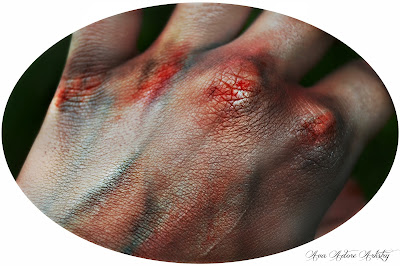My goals in life are endless, and the best artists have pages of goals.
One of my goals is to be a Special Effects Makeup Artist or anything in that field.
I am in college for Theatrical Makeup at University of Wisconsin - River Falls.
I know what I have the ability to create, I stress about it daily. Today I decided to step foot and do a simple SFX Design.
Bruises in Special Effects are essential in a Horror movie or anything really.
Bruises are not gory as like slashes and gashes but they still are a little "weird" and "gross looking".
In movies, if a brick is going to fall on you---you will get a nasty bruise.
Making it look believable is the goal in SFX Makeup.
Process of Creating
It's all about layering and blending!
My tips are to use translucent powder each layer to make it set and all have the same consistency.
I used Ben Nye products as shown below:
My tips are to use translucent powder each layer to make it set and all have the same consistency.
I used Ben Nye products as shown below:
I barley used the top image shown due to the fact of them being too bright of colors. The top image I mostly used for the vein effects of highlighting my natural blue veins. I mostly used the bottom image of the Ben Nye's more "bruised" color wheel.

To look believable, the right color schemes matter.

Lighting Differences
The lighting difference create a different overall mood. When choosing what you're doing, always put lighting and where you're going to shoot into context. Also, camera quality. My phone camera barley picks up the details I have compared to my DSLR Nikon D300 camera. As an artist, that has to be thought about.




No comments:
Post a Comment